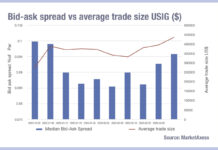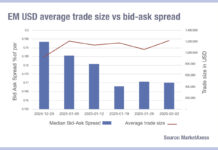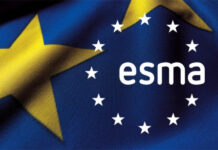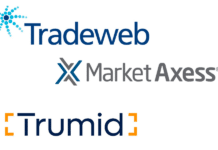The ability to use new trading protocols can be highly dependent upon the funds that a desk trades for and the types of instruments that it manages.
Sell-side firms have been keen to support new ways of negating with clients but do not always have the capacity to continue supporting these methods, such as portfolio trading or direct streaming, as the pay-off is not always great enough. Speaking at the Fixed Income Leader Summit in Nashville, traders reported very different success levels, based on technology, trading styles and capabilities.

“We have not had a lot of the success with portfolio trading (PT) to date, but that if we go into that a little bit, we’re trading short duration fixed income a lot of the time,” explained Karl Lohninger, executive director and corporate credit trader at JP Morgan Asset Management.

“You are not going to be getting an offer on them if you include them in a portfolio trade.” Britni Ihle, head of credit algo & fixed income ETF trading for North America at Citi agreed with Lohninger on the need for appropriate application of PT but outlined a positive case for its value. “Portfolio trading is a newer protocol and it’s really been growing over the past five years; at this point, it’s around 8%, of TRACE by volume,” she said. “We really see it as helpful to some of our larger, real money clients, although that’s not exclusively true. It’s not necessarily automated, or high tech, it can be an RFQ protocol that trades in list format, and it’s all or none.”

Steven Chylinski, head of fixed income trading at Eagle Asset Management noted that his firm had not had great success with portfolio trading either, but asked, “When buy-side clients are presenting a portfolio trade to you, what’s the best way to package it? Is there a best way with a mix of sells and buys, or various liquidity scores? Ihle said, “The pricing will vary based on how you package it. The pricing will be tightest if it’s quite diversified, and looks like an index or ETF. It won’t matter if it’s a rebalance, if it’s a mix between buys or sells or if it’s directional. We’ll get wider pricing if it’s something that’s a lot more concentrated, and you’re trying to remove a specific risk.
So really, there’s a full spectrum of options; we do price all of them, but the pricing will vary.” As firms apply technology such as artificial intelligence to their trading platforms even more sophisticated ways of finding pre-trade transparency are evolving. AJ Cass, head of market structure and liquidity, at LTX, a Broadridge company said, “We just launched BondGPT, which is a large language model, and can take everyday questions a PM or trader might want to ask, and instead of working across 1700 different spreadsheets, they can ask it simple questions.
An example would be to asking to see AA bonds that mature in five years, which are trading higher than a 8% yield and trade lower than a given price. It will actually spit out the list of those bonds, and go one step further, you can click into those bonds and see which one of your dealers – if you want to buy or sell – you can interact with.”
Chylinski noted that LTX had also begun to develop new ideas for trading protocols which could lead to traders engaging with each other in new ways. “I think we’re getting to a point where there might be new innovative protocols such as the one which LTX has just announced today, which will be interesting for us all to play with, this RFQ+.
It creates all those bids and takes the time to hit the best bid, and call covered bids – this could potentially be all automated and the dealers still getting a good price.” The DESK
©Markets Media Europe 2023


























